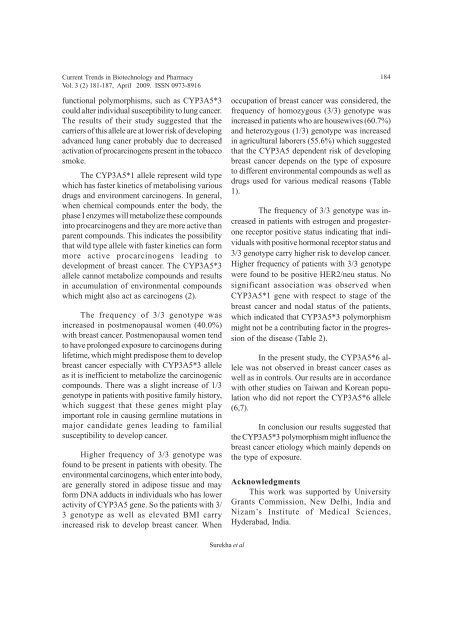April Journal-2009.p65 - Association of Biotechnology and Pharmacy
April Journal-2009.p65 - Association of Biotechnology and Pharmacy
April Journal-2009.p65 - Association of Biotechnology and Pharmacy
You also want an ePaper? Increase the reach of your titles
YUMPU automatically turns print PDFs into web optimized ePapers that Google loves.
Current Trends in <strong>Biotechnology</strong> <strong>and</strong> <strong>Pharmacy</strong><br />
Vol. 3 (2) 181-187, <strong>April</strong> 2009. ISSN 0973-8916<br />
functional polymorphisms, such as CYP3A5*3<br />
could alter individual susceptibility to lung cancer.<br />
The results <strong>of</strong> their study suggested that the<br />
carriers <strong>of</strong> this allele are at lower risk <strong>of</strong> developing<br />
advanced lung caner probably due to decreased<br />
activation <strong>of</strong> procarcinogens present in the tobacco<br />
smoke.<br />
The CYP3A5*1 allele represent wild type<br />
which has faster kinetics <strong>of</strong> metabolising various<br />
drugs <strong>and</strong> environment carcinogens. In general,<br />
when chemical compounds enter the body, the<br />
phase I enzymes will metabolize these compounds<br />
into procarcinogens <strong>and</strong> they are more active than<br />
parent compounds. This indicates the possibility<br />
that wild type allele with faster kinetics can form<br />
more active procarcinogens leading to<br />
development <strong>of</strong> breast cancer. The CYP3A5*3<br />
allele cannot metabolize compounds <strong>and</strong> results<br />
in accumulation <strong>of</strong> environmental compounds<br />
which might also act as carcinogens (2).<br />
The frequency <strong>of</strong> 3/3 genotype was<br />
increased in postmenopausal women (40.0%)<br />
with breast cancer. Postmenopausal women tend<br />
to have prolonged exposure to carcinogens during<br />
lifetime, which might predispose them to develop<br />
breast cancer especially with CYP3A5*3 allele<br />
as it is inefficient to metabolize the carcinogenic<br />
compounds. There was a slight increase <strong>of</strong> 1/3<br />
genotype in patients with positive family history,<br />
which suggest that these genes might play<br />
important role in causing germline mutations in<br />
major c<strong>and</strong>idate genes leading to familial<br />
susceptibility to develop cancer.<br />
Higher frequency <strong>of</strong> 3/3 genotype was<br />
found to be present in patients with obesity. The<br />
environmental carcinogens, which enter into body,<br />
are generally stored in adipose tissue <strong>and</strong> may<br />
form DNA adducts in individuals who has lower<br />
activity <strong>of</strong> CYP3A5 gene. So the patients with 3/<br />
3 genotype as well as elevated BMI carry<br />
increased risk to develop breast cancer. When<br />
184<br />
occupation <strong>of</strong> breast cancer was considered, the<br />
frequency <strong>of</strong> homozygous (3/3) genotype was<br />
increased in patients who are housewives (60.7%)<br />
<strong>and</strong> heterozygous (1/3) genotype was increased<br />
in agricultural laborers (55.6%) which suggested<br />
that the CYP3A5 dependent risk <strong>of</strong> developing<br />
breast cancer depends on the type <strong>of</strong> exposure<br />
to different environmental compounds as well as<br />
drugs used for various medical reasons (Table<br />
1).<br />
The frequency <strong>of</strong> 3/3 genotype was increased<br />
in patients with estrogen <strong>and</strong> progesterone<br />
receptor positive status indicating that individuals<br />
with positive hormonal receptor status <strong>and</strong><br />
3/3 genotype carry higher risk to develop cancer.<br />
Higher frequency <strong>of</strong> patients with 3/3 genotype<br />
were found to be positive HER2/neu status. No<br />
significant association was observed when<br />
CYP3A5*1 gene with respect to stage <strong>of</strong> the<br />
breast cancer <strong>and</strong> nodal status <strong>of</strong> the patients,<br />
which indicated that CYP3A5*3 polymorphism<br />
might not be a contributing factor in the progression<br />
<strong>of</strong> the disease (Table 2).<br />
In the present study, the CYP3A5*6 allele<br />
was not observed in breast cancer cases as<br />
well as in controls. Our results are in accordance<br />
with other studies on Taiwan <strong>and</strong> Korean population<br />
who did not report the CYP3A5*6 allele<br />
(6,7).<br />
In conclusion our results suggested that<br />
the CYP3A5*3 polymorphism might influence the<br />
breast cancer etiology which mainly depends on<br />
the type <strong>of</strong> exposure.<br />
Acknowledgments<br />
This work was supported by University<br />
Grants Commission, New Delhi, India <strong>and</strong><br />
Nizam’s Institute <strong>of</strong> Medical Sciences,<br />
Hyderabad, India.<br />
Surekha et al













